Curtiss P-60 Video - Picture
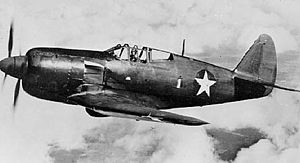
|
|
Curtiss P-60
P-60

Picture - Curtiss XP-60C in flight, modified from second XP-60A, with Pratt & Whitney R-2800 engine and contra-rotating propellers.
Role: Fighter aircraft
Manufacturer: Curtiss-Wright
First flight: 18 September 1941
Retired: 22 December 1944
Status: Cancelled
Primary user: United States Army Air Forces
Produced: 1942-1944
Number built: 5 (all converted into new variants)
Program cost: $8.88 million USD
Developed from: Curtiss XP-46
Curtiss XP-53
The Curtiss P-60 was a 1940s United States single-engine single-place, low-wing monoplane fighter aircraft developed by the Curtiss-Wright company as a successor to their P-40. It went through a lengthy series of prototype versions, eventually evolving into a design that bore little resemblance to the P-40. None of these versions reached production.
Design and development
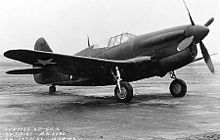
Picture - XP-60A with Allison V-1710-75 engine
The initial design contained in proposals to the United States Army Air Corps was for an aircraft based upon the P-40 design but featuring a low drag laminar flow wing, a Continental XIV-1430-3 inverted vee engine, and eight wing-mounted 0.5 in (12.7 mm) machine guns. This proposal was accepted and a contract for two prototypes was issued on 1 October 1940 with the aircraft designated the XP-53.
Within two months the Army Air Corps modified the contract to require the second prototype be completed with a Rolls-Royce Merlin engine in place of the XIV-1430. That aircraft was re-designated XP-60. The airframe design for the XP-60 was modified for the different engine, and the main landing gear was changed from the rearward retracting P-40 design to a new inward retracting version, which allowed a wider wheelbase and a smooth wing surface when the gear was retracted. This aircraft first flew on 18 September 1941 with a British-built Merlin 28 engine. The XP-53 prototype was then converted into a static test airframe for the XP-60.
Considering delivery delays of quantities of the Packard-built Merlin engines due to its use in other fighters, the use of a turbo-supercharged Allison V-1710-75 engine was considered in its place. Consequently, on 31 October 1941, a contract for 1,950 P-60A fighters using the Allison engine, was awarded.

Picture - XP-60A with Allison V-1710-75 engine
Operational history
In the meantime, flight tests of the XP-60 prototype were not progressing smoothly. In addition to landing gear problems, expected top speed was not being met due to shortcomings in the laminar-flow wing surface finish, relatively high radiator drag (compared to the North American P-51 Mustang, which was then flying), and less than specified engine output performance. Consequently, work on the P-60A was stopped on 20 December 1941, when the USAAC recommended that Curtiss concentrate on licence production of Republic P-47 Thunderbolts.
On 2 January 1942 the order was changed to produce one XP-60A with the Allison V-1710-75 engine and a General Electric B-14 turbo-supercharger, one XP-60B with the Allison V-1710-75 engine and a Wright SU-504-1 turbo-supercharger, and one XP-60C with the massive Chrysler XIV-2220 sixteen cylinder inverted vee engine.
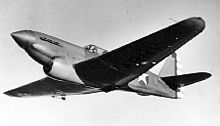
Picture - XP-60B in flight test with Allison V-1710-75 engine and a Wright SU-504-1 turbo-supercharger
At the time, availability of the Chrysler engine was coming into question, and after Curtiss noted that several hundreds of pounds of lead would be needed in the tail of the existing airframe for balance, a decision was made to install a Pratt & Whitney R-2800 radial engine in the XP-60C. In the meantime, Curtiss installed a Merlin 61 engine in the original XP-60 and after enlarging the vertical tail surface, this aircraft was re-designated XP-60D.
The XP-60A first flew on 1 November 1942. While official interest in the P-60 waned during summer 1942, interest due to the promise of improved performance with the installation of the R-2800 engine resulted in a contract for 500 R-2800 powered P-60A-1-CU fighters with contra-rotating propellers. With concern that the contra-rotating propellers would not be available on time, the XP-60B was modified to take the R-2800-10 engine driving a four bladed propeller. This modification was re-designated XP-60E.
On 27 January 1943, the XP-60C flew for the first time, powered by a R-2800-53 engine with contra-rotating propellers. The aircraft's flying characteristics were found to be generally satisfactory. The first flight of the XP-60E with the four-bladed propeller, was delayed until 26 May 1943 after it was found that due to its lighter weight, the engine installation had to be moved 10 inches forward compared to the XP-60C.
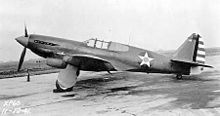
Picture - XP-60D with Merlin 61 engine
In April 1943, the US Army Air Force decided to conduct an evaluation of the various fighter aircraft in development and use, in order to eliminate the least desirable models. Curtiss was requested to have the XP-60E participate. As the XP-60E was not available, the company hurriedly prepared the XP-60C for the evaluation at Patterson Field. In the event, due to various issues, the XP-60C performed poorly, resulting in reduction of the production run of 500 aircraft to two aircraft.
In January 1944, the XP-60E was flown to Eglin Field for official trials, where Army Air Force pilots found that it did not compare favorably to contemporary aircraft designs. When Curtiss expressed the desire to abandon further work on the P-60 series, the Army Air Force insisted upon completion of one of the two aircraft in production. The aircraft when originally ordered was designated YP-60A-1-CU was re-designated YP-60E. This aircraft flew on 13 July 1944 and was subsequently delivered to Wright Field. The YP-60E differed mainly from the XP-60E in being powered by a 2,100 hp (1,566 kW) R-2800-18 engine as well as the fitting of an all-round vision bubble canopy.
With the development contracts cancelled in June 1943, the program ended ignobly when the last prototype was scrapped on 22 December 1944.To replace the P-60, Curtiss built 354 Republic P-47Gs instead for the USAAF.
Variants
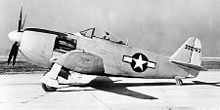
Picture - YP-60E with bubble canopy, revised engine, 4-blade propeller
XP-53
Curtiss Model 88; derivative of XP-46 to Request for Data R40-C specifications. Laminar flow wing and Continental XIV-1430-3 engine. Contracted for 1 October 1940; cancelled in favour of XP-60 in November 1941. One static test airframe built.
XP-60
Curtiss Model 90; Rolls-Royce Merlin engine, armament 8 .50-cal machine guns. One built, first flight 18 September 1941; modified to XP-60D.
XP-60A
Curtiss Model 95A; Allison V-1710-75 engine with B-14 turbosupercharger; armament: six .50-cal MG. One built.
P-60A
Planned production version of XP-60; 1900 ordered, all cancelled.
YP-60A-1
Pre-production version of P-60A-1 with single prop. Twenty-six ordered; two built; one rebuilt as YP-60E.
P-60A-1
Planned production version of XP-60C with Pratt & Whitney R-2800-18 engine and contraprop; armament: four .50-cal MG. 500 ordered; cancelled before any built.
XP-60B
Curtiss Model 95B; V-1710-75 engine with SU-504-2 turbosupercharger; armament: six .50-cal MG. One built, modified to XP-60E.
XP-60C
Curtiss Model 95C; planned for Chrysler XIV-2220 engine, built with R-2800-53 and contraprop; armament: six .50-cal MG. One built. Rebuilt as XP-60E; original XP-60E rebuilt as XP-60C.
XP-60D
Rebuilt XP-60. Curtiss Model 90B; Packard V-1650-3 engine; crashed 6 May 1943.
XP-60E
Rebuilt XP-60B. Curtiss Model 95D; R-2800-10 engine; crashed January 1944. XP-60C reconfigured to XP-60E status.
YP-60E
Modified YP-60A-1 with bubble canopy. First flight 15 July 1944; cancelled 22 December 1944.
XP-60F
Planned modification of YP-60A-1 with different model of R-2800; cancelled before conversion.
Specifications (XP-60C)
General characteristics
Crew: 1
Length: 33.92 ft (10.34 m)
Wingspan: 41.33 ft (12.60 m)
Height: 12.33 ft (3.76 m)
Wing area: 275 ft² (25.6 m²)
Empty weight: 8,698 lb (3,945 kg)
Loaded weight: 10,785 lb (4,892 kg)
Powerplant: 1x— Pratt & Whitney R-2800-53 radial engine, 2,000 hp (1,492 kW)
Performance
Maximum speed: 414 mph (360 kn, 666 km/h)
Service ceiling: 37,900 ft (11,600 m)
Rate of climb: 3,890 ft/min (19.8 m/s)
Wing loading: 39.2 lb/ft² (191 kg/m²)
Power/mass: 0.19 hp/lb (300 W/kg)
Armament
Guns: 4 x— .50 in (12.7 mm) M2 Browning machine guns
Related development
Curtiss P-40
Bibliography
Bowers, Peter M. Curtiss Aircraft, 1907-1947. London: Putnam & Company Ltd., 1979. ISBN 978-0-370-10029-6.
Dorr, Robert F. and Jon Lake. Fighters of the United States Air Force. London: Temple Press, 1990. ISBN 978-0-600-55094-5.
Green, William. War Planes of the Second World War, Volume Four: Fighters. London: MacDonald & Co. (Publishers) Ltd., 1961 (Sixth impression 1969). ISBN 978-0-356-01448-7.
Green, William and Gordon Swanborough. WW2 Aircraft Fact Files: US Army Air Force Fighters, Part 1. London: Macdonald and Jane's Publishers Ltd., 1977. ISBN 978-0-356-08218-9.
Jones, Lloyd S. U.S. Fighters: 1925-1980s. Fallbrook, California: Aero Publishers, Inc., 1975. ISBN 978-0-8168-9200-6.
Norton, Bill. U.S. Experimental & Prototype Aircraft Projects: Fighters 1939-1945. North Branch, Minnesota: Specialty Press, 2008, pp. 80-85. ISBN 978-1-58007-109-3.
Curtiss P-60 Pictures
More aircraft.
Source: WikiPedia